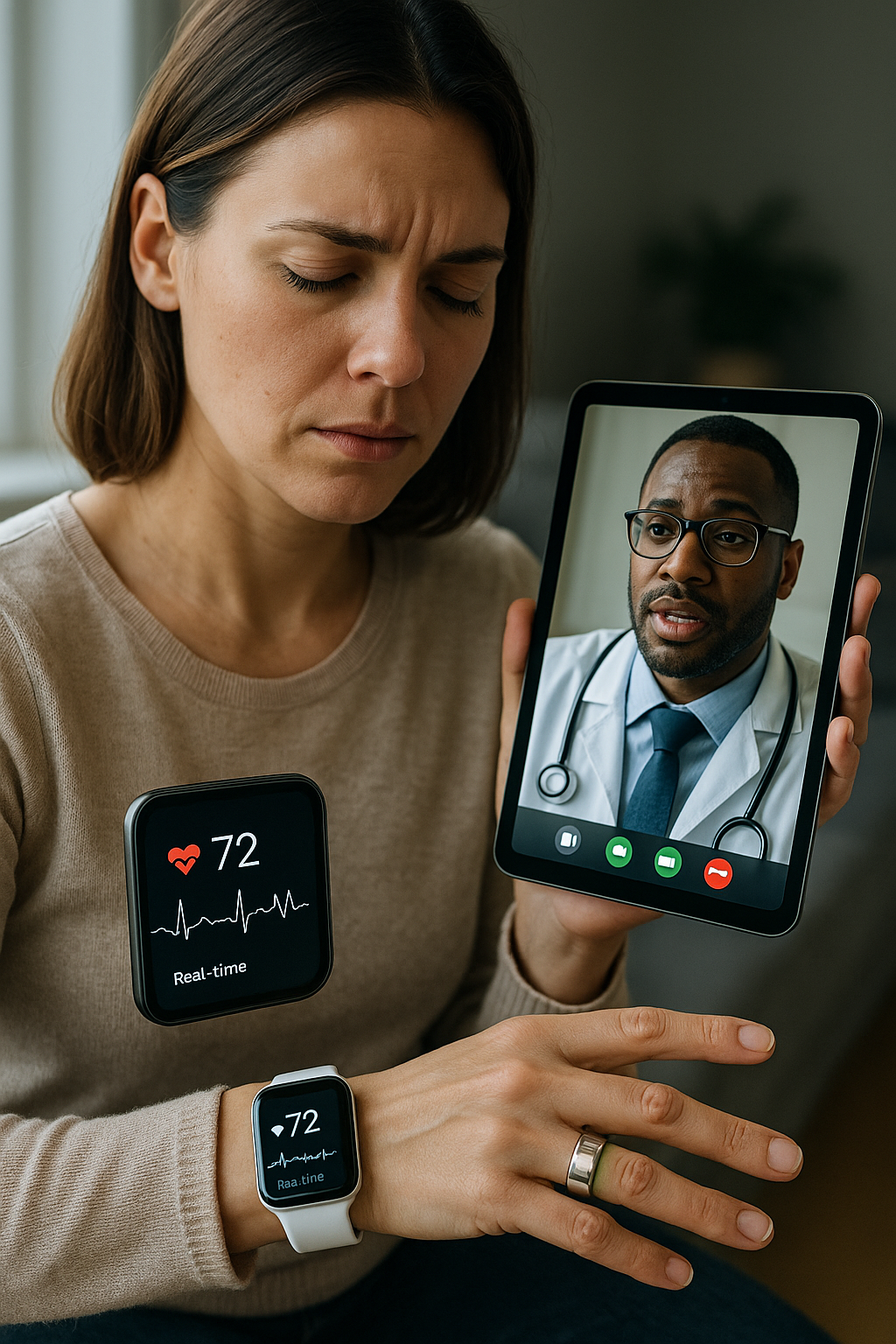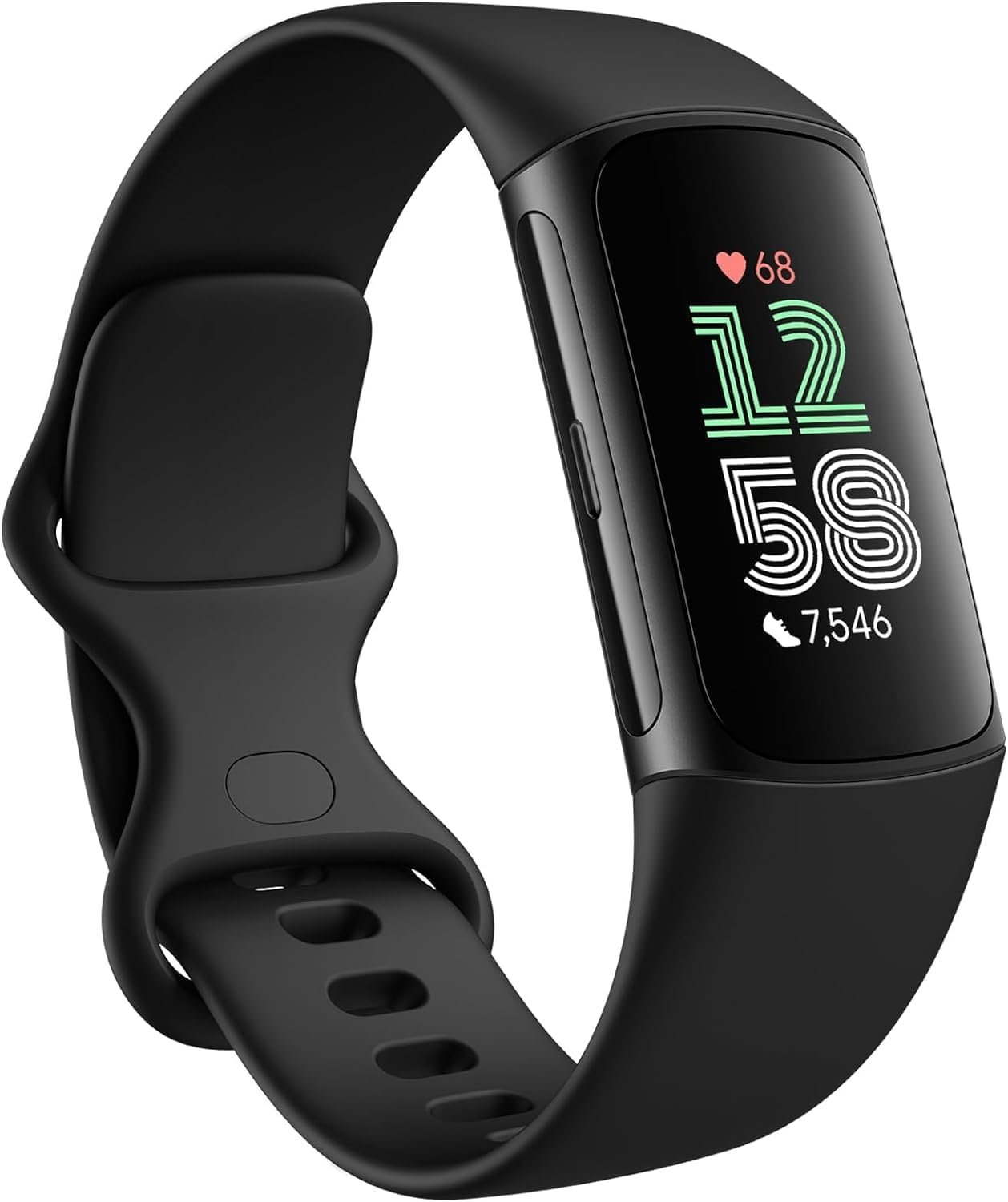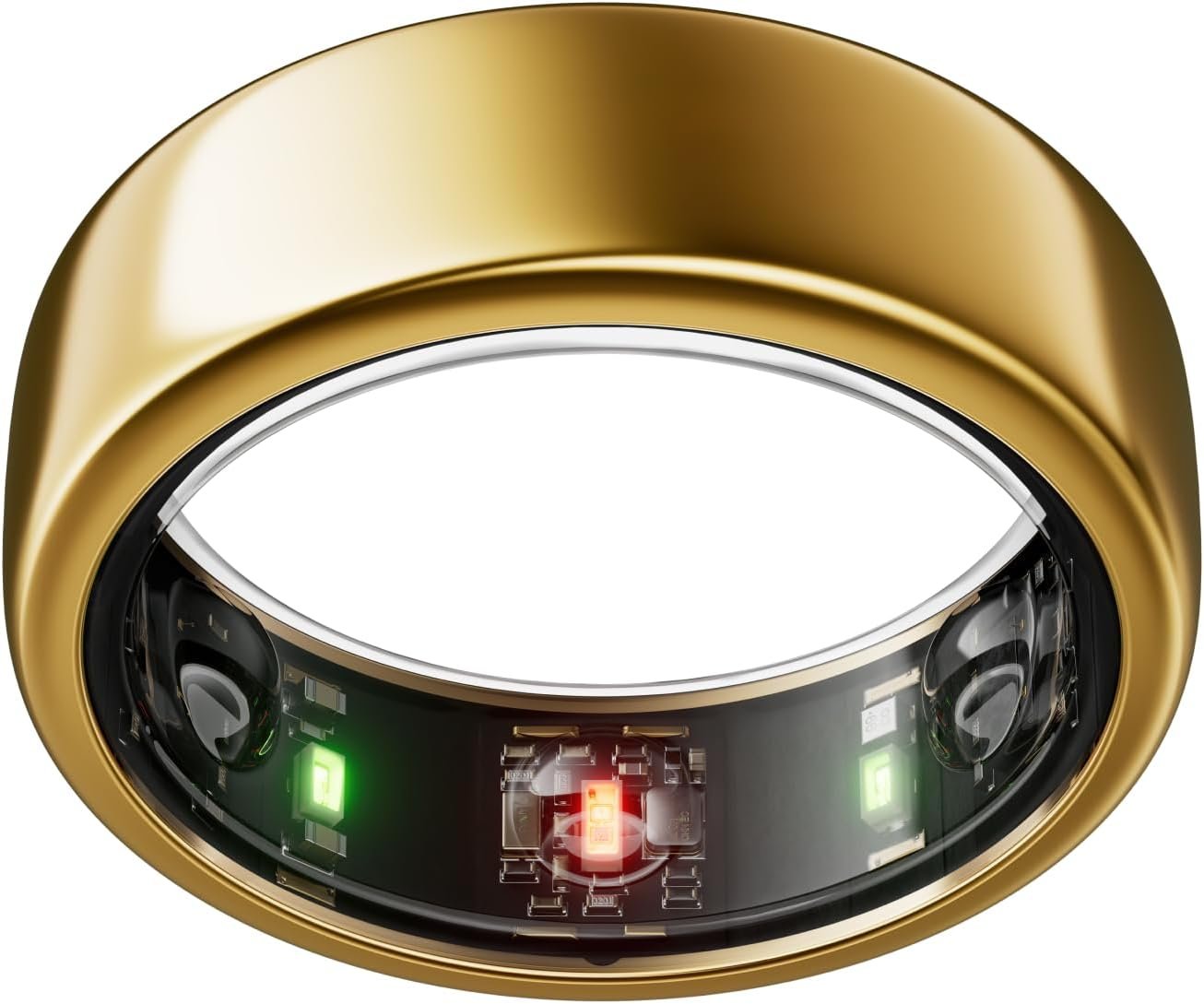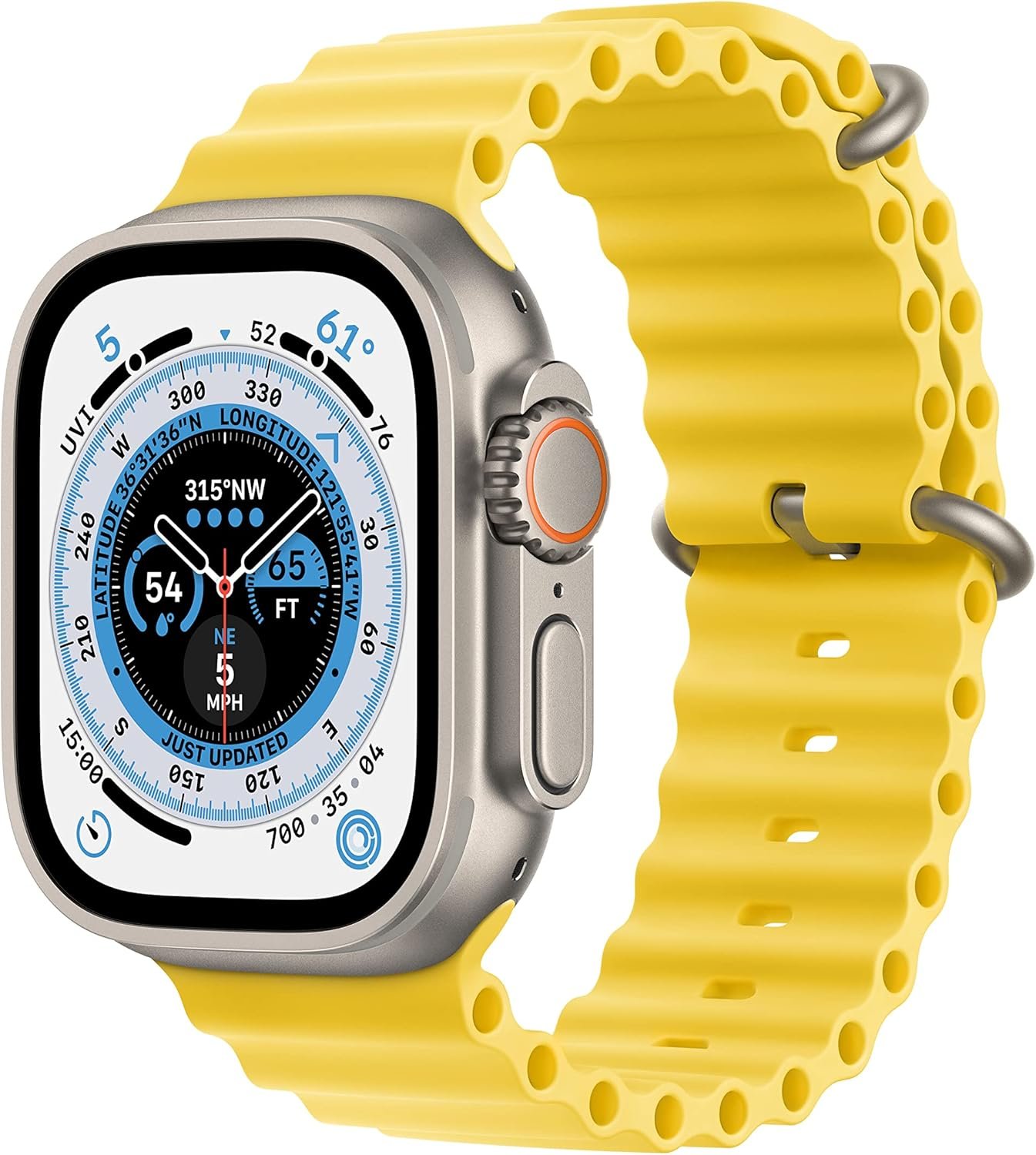AI wearables are transforming healthcare beyond fitness tracking. Discover how 400 million users are reshaping medicine through predictive algorithms and continuous monitoring in 2025.
Your smartwatch detects an irregular heartbeat at 3 AM, automatically schedules a cardiology appointment, and sends your six-month ECG data to your doctor—all before you wake up. This isn’t science fiction; it’s Tuesday morning in 2025. Over 400 million people now wear AI-powered health devices that don’t just track—they predict, prescribe, and sometimes panic.
Here’s the uncomfortable truth lurking beneath those sleek titanium cases: we’re witnessing the quiet transformation of wearable devices from fitness companions into unauthorized medical practitioners. The question isn’t whether AI wearables will revolutionize healthcare—they already have. The real question is whether we’re ready for machines that know our bodies better than we do.

The Great Wearable Divide: Fitness Trackers vs Medical Oracles
Fitbit: The Aging Marathon Runner
Fitbit built an empire on gamified fitness, and it shows. With bulletproof durability and unmatched value proposition, Fitbit remains the go-to choice for anyone wanting to “sweat smart.” Their step challenges, badge systems, and social competitions create powerful behavioral loops that genuinely motivate millions to move more.
Yet in the AI revolution, Fitbit increasingly resembles a marathon runner hitting the wall. While competitors dive deep into sophisticated biometrics, Fitbit clings to its fitness-first philosophy. Their sleep algorithms feel primitive compared to newer players, and their health insights remain frustratingly surface-level. It’s like bringing a calculator to an AI conference—functional, reliable, but missing the point entirely.
The verdict? Fitbit excels for movement motivation but struggles to convince users seeking comprehensive health optimization. In an era where wearables are becoming medical devices, being “just” a fitness tracker might not be enough.
Oura Ring: The Silent Sleep Whisperer
At the opposite extreme sits the Oura ring, a masterclass in focused excellence. This elegant finger-worn sensor has transformed sleep monitoring from crude approximations into precise physiological mapping. By measuring skin temperature, heart rate variability, and sleep architecture with remarkable accuracy, Oura turns every morning into a personalized health briefing.
Oura’s genius lies in understanding what elite athletes have known for decades: recovery is as crucial as performance. Their readiness scores and recovery recommendations have influenced everyone from NBA players to Silicon Valley executives, creating a culture where sleep optimization becomes as important as morning workouts.
But this laser focus creates limitations. At $300-400, Oura asks users to invest significantly in a device that primarily shines during unconscious hours. It’s like owning a Ferrari that only works at night—impressive performance within constraints, but limited versatility for daily health management.
Apple Watch: The Medical Ecosystem Emperor
Then there’s Apple, playing an entirely different game. The Apple Watch doesn’t just measure health metrics—it aims to become your wrist-mounted physician. With FDA-cleared ECG monitoring, atrial fibrillation detection, blood oxygen measurement, and fall detection, Apple has audaciously transformed consumer electronics into certified medical devices.
This medical ambition creates both opportunities and overwhelm. The Apple Watch can detect heart conditions that might otherwise go unnoticed for years, potentially saving thousands of lives. Yet it also generates a constant stream of health notifications that can transform routine daily life into medical anxiety. Between breathing reminders, heart rate alerts, and activity nudges, the Apple Watch risks becoming less health companion and more digital hypochondriac creator.
The ecosystem lock-in is real: maximizing Apple Watch health benefits requires complete commitment to Apple’s walled garden. Android users need not apply for this particular medical revolution.
The AI Revolution Hidden in Plain Sight
The real transformation isn’t happening in the sleek hardware designs or colorful app interfaces—it’s occurring in the invisible AI algorithms processing billions of physiological data points every second. Modern wearables employ machine learning systems that continuously analyze patterns, detect anomalies, and make predictions about your health trajectory.
Consider the complexity: your wearable simultaneously monitors heart rate variability, skin conductance, movement patterns, sleep cycles, and environmental factors. AI algorithms then weave these disparate data streams into coherent health narratives, identifying patterns that would escape even experienced physicians analyzing the same data manually.
This represents a fundamental shift from reactive to predictive healthcare. Instead of seeking medical attention after symptoms appear, AI wearables promise to detect problems before you feel them. Your device might notice declining heart rate variability weeks before you experience fatigue, or identify sleep pattern changes that predict mood disorders.
But here’s the unsettling reality: these algorithms are learning to know your body better than you know yourself. They can predict when you’ll feel tired, when you’re getting sick, and when you need recovery days—sometimes with uncanny accuracy.
The Four Ways AI Wearables Are Rewiring Healthcare
1. Democratizing Advanced Diagnostics
Traditional medical diagnostics require expensive equipment, specialized technicians, and clinical appointments. AI wearables are flipping this model by bringing hospital-grade monitoring to consumer devices.
The Apple Watch’s ECG capability exemplifies this transformation. What once required a cardiologist’s office visit now happens instantly on your wrist. The device can detect atrial fibrillation—a potentially dangerous heart rhythm disorder—with clinical-grade accuracy. Early detection of AFib can prevent strokes, making this consumer device a literal lifesaver.
Similarly, continuous glucose monitors originally designed for diabetes patients are now being adopted by health-conscious consumers seeking metabolic optimization. Companies like Levels and NutriSense use AI to interpret glucose data, providing personalized dietary recommendations that go far beyond traditional diabetes management.
The ripple effect is profound: millions of people now have access to diagnostic capabilities that were previously reserved for medical facilities. This democratization is particularly impactful in underserved communities where healthcare access remains limited.
2. Creating Continuous Patient Monitoring
Traditional medicine operates through episodic encounters—you visit a doctor when sick, receive treatment, and hopefully recover. AI wearables enable continuous monitoring that captures the full spectrum of your physiological story.
For cardiologists, this transformation is revolutionary. Instead of interpreting a 10-second ECG during an office visit, physicians can now analyze weeks or months of continuous heart rhythm data. Patterns that might be missed during brief clinical encounters become clearly visible through extended monitoring.
Dr. Sarah Chen, a cardiologist at Stanford Medical Center, describes the impact: “I can now see how my patient’s heart responds to different medications, stress levels, sleep patterns, and exercise routines. It’s like having a detailed physiological diary instead of occasional snapshots.”
This continuous monitoring is particularly valuable for chronic disease management. Patients with heart failure, diabetes, or hypertension can provide their healthcare teams with rich, objective data that enables more precise treatment adjustments and earlier intervention when problems arise.
3. Behavioral Modification Through Gamification
Perhaps the most underestimated impact of AI wearables lies in their ability to modify human behavior through sophisticated gamification systems. These devices don’t just measure activity—they shape it through carefully designed psychological incentives.
The mechanics are surprisingly sophisticated. Wearables use variable reward schedules, social comparison features, streak tracking, and personalized challenges to create powerful behavioral modification loops. The “closing your rings” phenomenon on Apple Watch or achieving daily step goals on Fitbit tap into the same psychological mechanisms that make video games addictive.
But AI makes this gamification far more sophisticated. Modern wearables learn your personal patterns and optimize motivation strategies accordingly. The device might notice you’re more likely to exercise in the morning, so it sends workout reminders at optimal times. It might recognize that social challenges motivate you more than personal goals, so it emphasizes community features.
Research published in the Journal of Medical Internet Research found that users of AI-powered fitness wearables increased their daily activity by an average of 1,850 steps compared to traditional pedometers—a difference that translates to significant long-term health benefits across millions of users.
4. Transforming Mental Health Monitoring
The most profound—and potentially concerning—development is AI wearables’ growing ability to monitor and predict mental health states. By analyzing combinations of heart rate variability, sleep patterns, activity levels, and even typing patterns on connected devices, AI systems can detect early signs of depression, anxiety, and other mental health conditions.
Companies like Ginger and Mindstrong use smartphone and wearable data to create “digital biomarkers” for mental health. Their algorithms can identify patterns associated with depressive episodes, manic phases in bipolar disorder, or increasing anxiety levels—sometimes before individuals recognize these changes themselves.
The University of California San Diego recently published research showing that AI analysis of wearable data could predict depressive episodes with 80% accuracy up to a week before traditional clinical assessments would detect them. This predictive capability could enable earlier interventions and prevent mental health crises.
However, this capability raises profound questions about privacy and autonomy. Should your employer have access to data suggesting you’re entering a depressive episode? What about insurance companies? The potential for discrimination based on predicted mental health states is enormous.
The Dark Side of Digital Health Omniscience
The Privacy Paradox
Every heartbeat, every step, every hour of sleep becomes data points in vast corporate databases. Apple, Google, Samsung, and other tech giants are accumulating unprecedented amounts of biological information about billions of users. This data is far more intimate than traditional digital footprints—it represents the physiological essence of our existence.
The privacy implications are staggering. Your wearable data can reveal pregnancy before you announce it, detect drug use, identify sexual activity, and predict illness. In the wrong hands, this information becomes a powerful tool for discrimination, manipulation, or control.
Current privacy policies offer little protection. Companies claim to anonymize health data, but research consistently shows that physiological data is nearly impossible to truly anonymize. Your unique heart rate patterns, sleep cycles, and activity signatures create biological fingerprints as distinctive as DNA.
The Reliability Roulette

Consumer wearables aren’t medical devices—except when they are. The Apple Watch has FDA clearance for specific functions, but most wearable health features exist in a regulatory gray zone. Accuracy varies dramatically between devices and use cases, creating dangerous gaps between perceived and actual reliability.
False positives create unnecessary anxiety and healthcare costs. Imagine receiving alerts about irregular heart rhythms that turn out to be device errors, leading to expensive cardiac evaluations and weeks of worry. False negatives might be worse—missing real health problems because users trust their devices to alert them to issues.
Dr. Michael Roizen, Chief Wellness Officer at Cleveland Clinic, warns: “These devices provide valuable information, but they’re not infallible. Users must understand their limitations and maintain appropriate skepticism about the data they generate.”
The Over-Medicalization Trap
Constant health monitoring can transform normal physiological variations into sources of anxiety. When every metric is tracked, measured, and analyzed, users risk developing what researchers call “digital hypochondria”—obsessive concern about health data that may not be clinically meaningful.
Sleep scores, readiness ratings, and recovery metrics can become sources of stress rather than health optimization tools. Users report feeling guilty about “poor” sleep scores or anxious about heart rate variations that fall within normal ranges but trigger device alerts.
This phenomenon reflects a broader cultural shift toward quantified self-optimization that may paradoxically harm wellbeing by creating unrealistic expectations for physiological perfection.
The Corporate Control Concern
Perhaps most troubling is the potential for corporate entities to influence health decisions through AI recommendations. When your wearable suggests seeing a doctor, taking a rest day, or changing your diet, these aren’t neutral medical recommendations—they’re algorithmic outputs from companies with commercial interests.
Apple’s health ecosystem exemplifies both the promise and peril of corporate health control. The company provides valuable health tools while simultaneously creating dependency on its ecosystem. Users become locked into Apple’s interpretation of their health data, making it difficult to switch platforms or seek alternative perspectives.
The fundamental question becomes: who ultimately controls your health decisions—you, your doctor, or your device’s algorithms?
Choosing Your Digital Health Philosophy
The wearable landscape reflects different philosophies about health, technology, and human agency. Your device choice isn’t just about features—it’s about the vision of health you want to embrace.
Fitbit represents the democratic fitness approach: health through movement, social motivation, and accessible technology. It’s ideal for users who believe that consistent activity and basic monitoring provide sufficient health insights without overwhelming complexity.
Oura embodies the precision recovery philosophy: health through optimization, deep physiological insights, and personalized recommendations. It appeals to users who view sleep and recovery as foundation elements requiring sophisticated monitoring and adjustment.
Apple Watch champions the integrated medical ecosystem: health through comprehensive monitoring, predictive analytics, and seamless healthcare integration. It’s designed for users comfortable with technology-mediated health management and willing to embrace algorithmic health guidance.
Each approach carries implicit assumptions about the role of technology in health, the value of data versus intuition, and the appropriate level of medicalization in daily life.
The Healthcare Professional’s Perspective: Enhancement, Not Replacement
As both a medical laboratory specialist and wearable technology user, I’ve witnessed how these devices transform clinical practice—predominantly for the better. The continuous monitoring capabilities have genuinely revolutionized patient care in ways that seemed impossible just a few years ago.
For cardiologists, having weeks of heart rhythm data instead of brief clinic snapshots represents a quantum leap in diagnostic capability. Some colleagues now provide Apple Watches to high-risk patients, enabling real-time monitoring that was previously impossible outside hospital settings. What once required expensive Holter monitors and complex logistics now fits elegantly on a wrist.
But here’s where AI becomes transformative: it can intelligently manage the massive data streams these devices generate, identifying patterns and anomalies that might escape even experienced clinicians reviewing thousands of data points.
However, I want to emphasize that my perspective on AI isn’t about replacing healthcare professionals—quite the opposite. AI will enhance our capabilities by providing comprehensive data collection and sophisticated analyses for each patient. The technology becomes our enhanced stethoscope, our digital diagnostic partner.
Yet human critical thinking remains irreplaceable. Algorithms can detect patterns, but they cannot understand the patient’s story, their concerns, their context. The art of medicine—the ability to synthesize data with human experience, empathy, and clinical judgment—cannot be automated.
The future of healthcare isn’t about choosing between human expertise and artificial intelligence—it’s about creating partnerships where technology amplifies our capabilities while we maintain the critical thinking and human connection that remain at the heart of healing.
The Road Ahead: Predictions for AI Wearables
Near-term developments (2025-2027):
- Continuous glucose monitoring will expand beyond diabetes management to become mainstream metabolic optimization tools
- Mental health prediction algorithms will achieve clinical accuracy, enabling proactive psychological interventions
- Multi-disease screening will emerge, with single devices monitoring for dozens of conditions simultaneously
- AI-powered personalization will create individually tailored health recommendations based on genetic, environmental, and behavioral data
Medium-term transformations (2027-2030):
- Regulatory frameworks will evolve to address the medical device status of consumer wearables
- Healthcare integration will become seamless, with wearable data automatically incorporated into electronic health records
- Predictive medicine will shift from reactive treatment to preventive intervention based on AI risk assessments
- Global health equity initiatives will leverage low-cost wearables to extend healthcare access to underserved populations
Long-term implications (2030+):
- Biological data ownership rights will be established through new privacy legislation
- AI health coaching will become as common as human healthcare providers for routine health management
- Preventive medicine paradigms will fundamentally shift as diseases are increasingly detected and prevented before symptoms appear
- Human-AI healthcare partnerships will evolve into sophisticated collaborative systems that enhance rather than replace human medical expertise
Conclusion: Embracing the Wearable Revolution Wisely
The AI wearable revolution isn’t coming—it’s here, strapped to our wrists and worn on our fingers, quietly reshaping how we understand and manage our health. These devices represent one of the most significant healthcare innovations of our lifetime, democratizing access to sophisticated health monitoring and creating unprecedented opportunities for disease prevention and wellness optimization.
But with great power comes great responsibility—both for developers and users. We must demand transparency in AI algorithms, robust privacy protections, and appropriate regulatory oversight. We must maintain healthy skepticism about device recommendations while remaining open to the genuine insights they provide. Most importantly, we must ensure that technology enhances rather than replaces human agency in health decisions.
The choice isn’t between embracing or rejecting wearable AI—it’s about how thoughtfully we integrate these powerful tools into our lives and healthcare systems. By understanding both the promise and perils of wearable AI, we can harness its potential while avoiding its pitfalls.
The future of health is being written in the algorithms analyzing your heartbeat, the sensors tracking your sleep, and the AI systems learning your biological patterns. The question isn’t whether this future will arrive—it’s whether we’ll shape it wisely.
What story will your wearable data tell about the future of human health? The answer depends on the choices we make today.
Recommended Reading:
- Digital Health: Scaling Healthcare to the World by Julio Frenk and Sherry Suyu
- The AI Revolution in Medicine: GPT-4 and Beyond by Peter Lee
Sources:
- Journal of Medical Internet Research: “Effectiveness of Wearable Activity Trackers in Increasing Physical Activity”
- Stanford Medicine: “Digital Health and Wearable Devices in Clinical Practice”
- University of California San Diego: “Digital Biomarkers for Mental Health Prediction”
- Cleveland Clinic: “Consumer Health Wearables: Promise and Limitations”
Disclaimer: This educational content was developed with AI assistance by a physician. It is intended for informational purposes only and does not replace professional medical advice. Always consult a qualified healthcare professional for personalized guidance. The information provided is valid as of the date indicated at the end of the article.




Comments